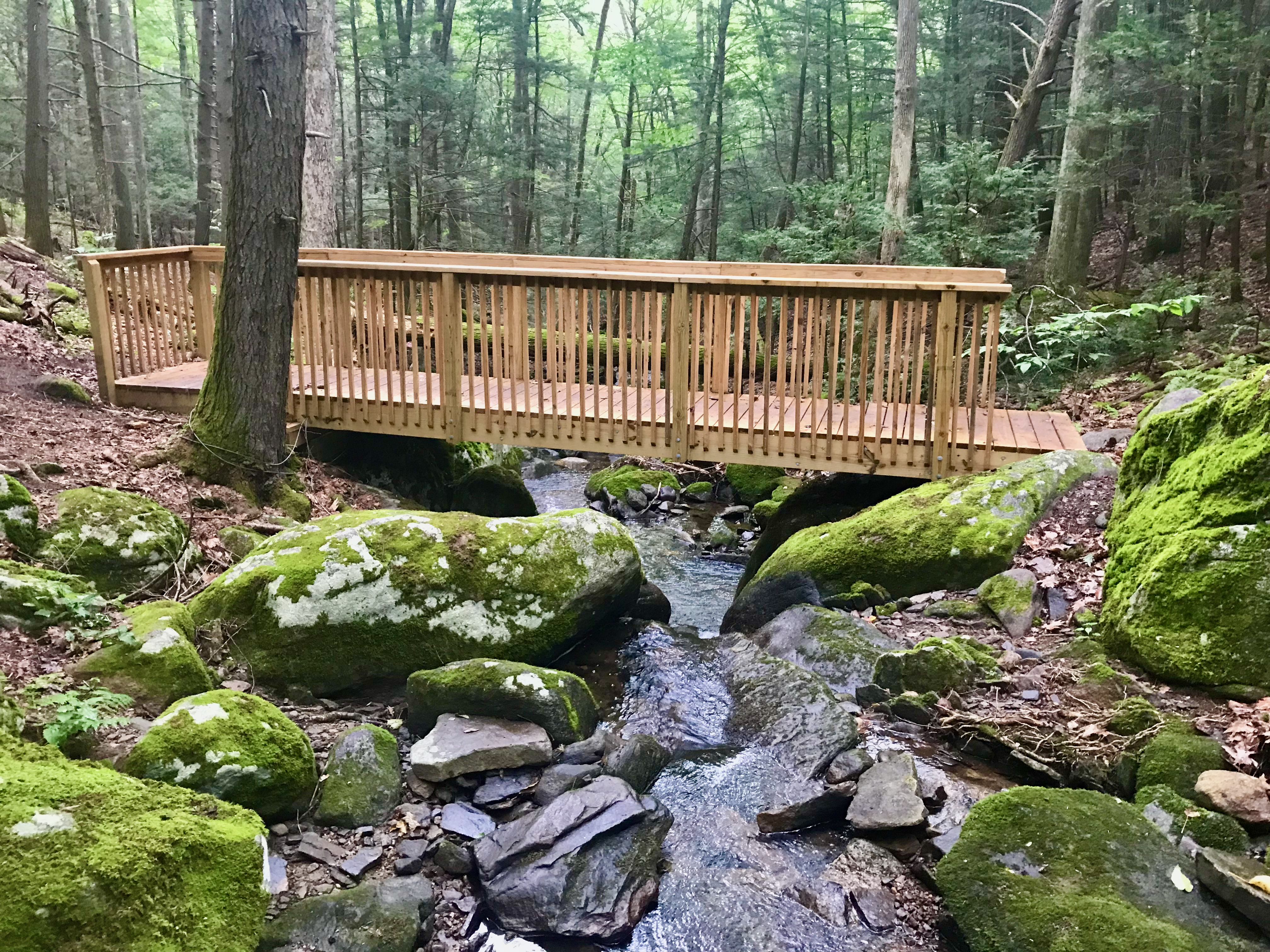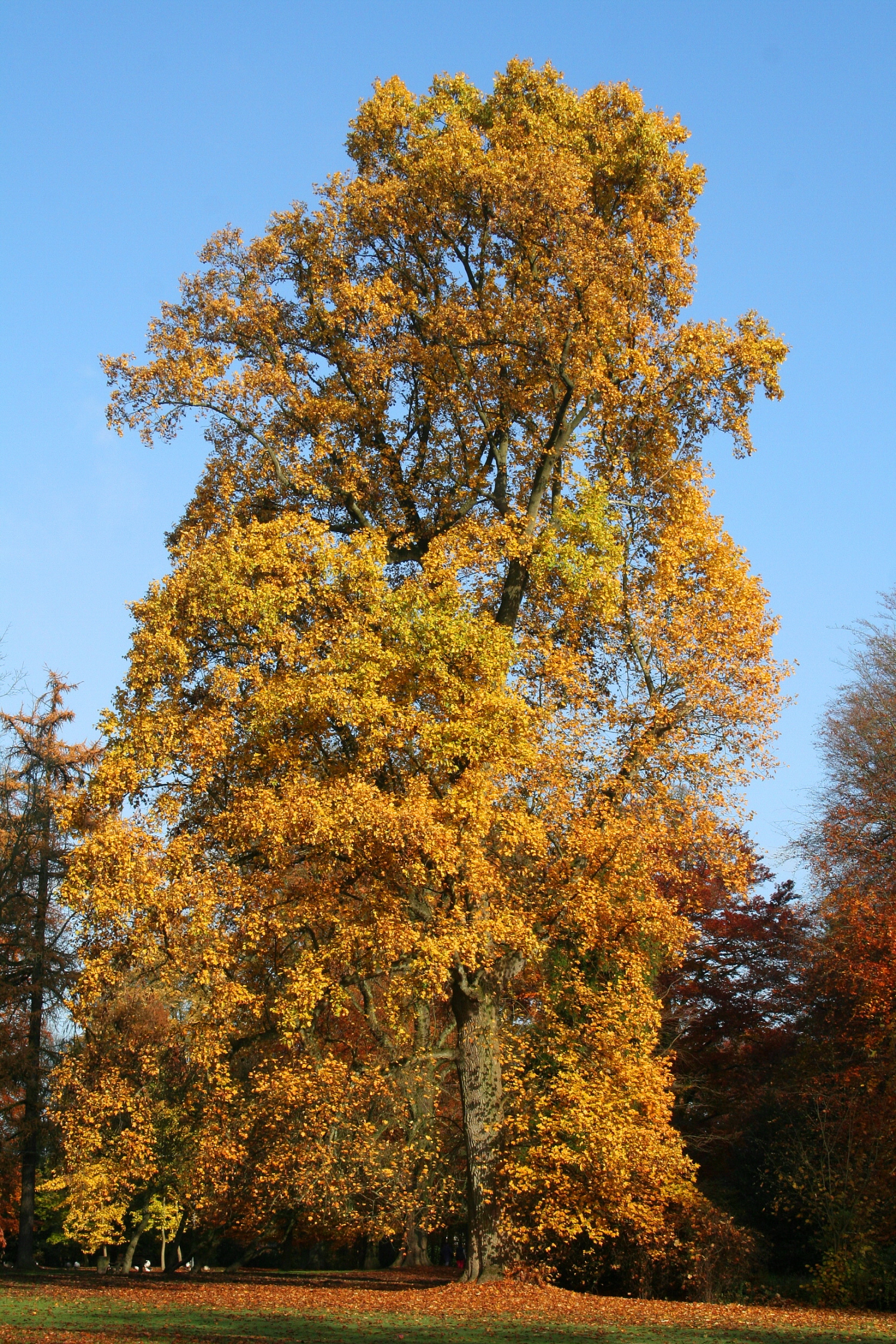|
Webb Mountain Park
Webb Mountain Park is a 135-acre municipal park in Monroe, Connecticut, offering hiking trails, rock climbing, nature study, and campsites. The park backs up onto land where a historic castle building and residences for nuns are located. Webb Mountain Discovery Zone nature center with its own 170 acre park is adjacent. The park has diverse flora including numerous kinds of trees, shrubs, and ferns that not only add to the aesthetic value of the place but provide an ideal setting for some amateur as well as scientific study of the local plants. It is adjacent to the town-owned Webb Mountain Discovery Zone. History Webb Mountain Park was a farm owned by the Mr. and Mrs. Alfred E. Wagner, purchased by the Town of Monroe in 1972. A 1979 study evaluated lands surrounding the park and in 2004, 170 acres of property adjacent were purchased by the town. In 2005, a study titled Webb Mountain Park Extension was carried out on the surrounding lands The adjacent property became Discovery ... [...More Info...] [...Related Items...] OR: [Wikipedia] [Google] [Baidu] |
Paugussett Trail
The Paugussett Trail is a '' Blue-Blazed'' hiking trail "system" in the lower Housatonic River valley in Fairfield County and, today, is entirely in Shelton and Monroe, Connecticut. Much of the trail is in Indian Well State Park and the Town of Monroe's Webb Mountain Park. The mainline (official "Blue-Blazed") trail is primarily southeast to northwest with three short side or spur trails. The Paugussett Trail today is composed of four (4) trails of which one is the upside-down V-shaped Southeast-to-North-to-SouthWest mainline trail (13.3 miles) plus three shorter side or access spur trails. The northernmost point on the trail is at Connecticut Route 34 and Lake Zoar's southern shore. Notable features include the initial steep climb near the Indian Well waterfall, a steep climb with stairs at Princess Wenonah Drive and semi-obscured scenic views of the Housatonic River.Connecticut Walk Book: A Trail Guide to the Connecticut Outdoors. 17th Edition. The Connecticut Forest and P ... [...More Info...] [...Related Items...] OR: [Wikipedia] [Google] [Baidu] |
Cornus Florida
''Cornus florida'', the flowering dogwood, is a species of flowering tree in the family Cornaceae native to eastern North America and northern Mexico. An endemic population once spanned from southernmost coastal Maine south to northern Florida and west to the Mississippi River. The tree is commonly planted as an ornamental in residential and public areas because of its showy bracts and interesting bark structure. Classification The flowering dogwood is usually included in the dogwood genus ''Cornus'' as ''Cornus florida'' L., although it is sometimes treated in a separate genus as ''Benthamidia florida'' (L.) Spach. Less common names for ''C. florida'' include American dogwood, Florida dogwood, Indian arrowwood, Cornelian tree, white cornel, white dogwood, false box, and false boxwood. Two subspecies are generally recognized: Description Flowering dogwood is a small deciduous tree growing to high, often wider than it is tall when mature, with a trunk diameter of up to . A ... [...More Info...] [...Related Items...] OR: [Wikipedia] [Google] [Baidu] |
Parks In Fairfield County, Connecticut
A park is an area of natural, semi-natural or planted space set aside for human enjoyment and recreation or for the protection of wildlife or natural habitats. Urban parks are green spaces set aside for recreation inside towns and cities. National parks and country parks are green spaces used for recreation in the countryside. State parks and provincial parks are administered by sub-national government states and agencies. Parks may consist of grassy areas, rocks, soil and trees, but may also contain buildings and other artifacts such as monuments, fountains or playground structures. Many parks have fields for playing sports such as baseball and football, and paved areas for games such as basketball. Many parks have trails for walking, biking and other activities. Some parks are built adjacent to bodies of water or watercourses and may comprise a beach or boat dock area. Urban parks often have benches for sitting and may contain picnic tables and barbecue grills. The larges ... [...More Info...] [...Related Items...] OR: [Wikipedia] [Google] [Baidu] |
Gneiss
Gneiss ( ) is a common and widely distributed type of metamorphic rock. It is formed by high-temperature and high-pressure metamorphic processes acting on formations composed of igneous or sedimentary rocks. Gneiss forms at higher temperatures and pressures than schist. Gneiss nearly always shows a banded texture characterized by alternating darker and lighter colored bands and without a distinct cleavage. Gneisses are common in the ancient crust of continental shields. Some of the oldest rocks on Earth are gneisses, such as the Acasta Gneiss. Description Orthogneiss from the Czech Republic In traditional English and North American usage, a gneiss is a coarse-grained metamorphic rock showing compositional banding (gneissic banding) but poorly developed schistosity and indistinct cleavage. In other words, it is a metamorphic rock composed of mineral grains easily seen with the unaided eye, which form obvious compositional layers, but which has only a weak tendency to fracture ... [...More Info...] [...Related Items...] OR: [Wikipedia] [Google] [Baidu] |
Amphibolite
Amphibolite () is a metamorphic rock that contains amphibole, especially hornblende and actinolite, as well as plagioclase feldspar, but with little or no quartz. It is typically dark-colored and dense, with a weakly foliated or schistose (flaky) structure. The small flakes of black and white in the rock often give it a salt-and-pepper appearance. Amphibolite frequently forms by metamorphism of mafic igneous rocks, such as basalt. However, because metamorphism creates minerals entirely based upon the chemistry of the protolith, certain 'dirty marls' and volcanic sediments may also metamorphose to an amphibolite assemblage. Deposits containing dolomite and siderite also readily yield amphibolite (tremolite-schist, grunerite-schist, and others) especially where there has been a certain amount of contact metamorphism by adjacent granitic masses. Metamorphosed basalt (metabasalt) creates ''ortho-amphibolite'' and other chemically appropriate lithologies create ''para-amphibolite''. ... [...More Info...] [...Related Items...] OR: [Wikipedia] [Google] [Baidu] |
Schist
Schist ( ) is a medium-grained metamorphic rock showing pronounced schistosity. This means that the rock is composed of mineral grains easily seen with a low-power hand lens, oriented in such a way that the rock is easily split into thin flakes or plates. This texture (geology), texture reflects a high content of platy minerals, such as micas, talc, chlorite group, chlorite, or graphite. These are often interleaved with more granular minerals, such as feldspar or quartz. Schist typically forms during regional metamorphism accompanying the process of mountain building (orogeny) and usually reflects a medium Metamorphism#Metamorphic grades, grade of metamorphism. Schist can form from many different kinds of rocks, including sedimentary rocks such as mudstones and igneous rocks such as tuffs. Schist metamorphosed from mudstone is particularly common and is often very rich in mica (a ''mica schist''). Where the type of the original rock (the protolith) is discernible, the schist is us ... [...More Info...] [...Related Items...] OR: [Wikipedia] [Google] [Baidu] |
Collinsville Formation
The Collinsville Formation is a geologic formation in the U.S. state of Connecticut. It is a metamorphic rock formation from the Middle Ordovician epoch. The U.S. Geological Survey description includes that its "most complete sequence is in Shelburne Falls dome where L.M. Hall has recognized seven mappable subdivisions. With minor modification, they are (ascending) 1) amphibolite with thin felsic gneiss layers; 2) rusty-weathering massive granulites; 3) very homogeneous garnetiferous biotite gneiss; 4) interlayered amphibolite and felsic gneiss; 5) felsic gneiss with scattered biotite +/- magnetite, garnet, and hornblende; 6) interbedded amphibolite and white felsic gneiss; and 7) gray, tan-weathering granulites containing thin coticule layers." Rock climbers use one of its features in Webb Mountain Park Webb Mountain Park is a 135-acre municipal park in Monroe, Connecticut, offering hiking trails, rock climbing, nature study, and campsites. The park backs up onto land w ... [...More Info...] [...Related Items...] OR: [Wikipedia] [Google] [Baidu] |
Monotropa Uniflora
''Monotropa uniflora'', also known as ghost plant, ghost pipe, or Indian pipe, is an herbaceous perennial plant native to temperate regions of Asia, North America, and northern South America, but with large gaps between areas. The plant is sometimes completely waxy white, but often has black flecks or pale pink coloration. Rare variants may have a deep red color. The name "Monotropa" is Greek for "one turn" and "uniflora" is Latin for "one flowered" as there is one sharply curved stem for each single flower. Description The stems reach heights of , sheathed with highly reduced leaves long, best identified as scales or bracts. These structures are small, thin, and translucent; they do not have petioles but instead extend in a sheath-like manner out of the stem. As its scientific name suggests, and unlike the related ''Monotropa hypopitys'' (but like the close relation '' Monotropastrum humile''), the stems bear a single flower long, with 3–8 translucent petals, 10–12 stamen ... [...More Info...] [...Related Items...] OR: [Wikipedia] [Google] [Baidu] |
Hepatica Americana
''Hepatica americana'', the round-lobed hepatica, is a herbaceous Herbaceous plants are vascular plants that have no persistent woody stems above ground. This broad category of plants includes many perennials, and nearly all annuals and biennials. Definitions of "herb" and "herbaceous" The fourth edition of t ... flowering plant in the buttercup family Ranunculaceae. It is native to the eastern United States and Canada. It is sometimes considered part of the genus '' Anemone'', as ''Anemone americana'', ''A. hepatica'', or ''A. nobilis''. References Ranunculaceae americana Flora of Northern America {{Ranunculaceae-stub ... [...More Info...] [...Related Items...] OR: [Wikipedia] [Google] [Baidu] |
Liriodendron Tulipifera
''Liriodendron tulipifera''—known as the tulip tree, American tulip tree, tulipwood, tuliptree, tulip poplar, whitewood, fiddletree, and yellow-poplar—is the North American representative of the two-species genus ''Liriodendron'' (the other member is ''Liriodendron chinense''), and the tallest eastern hardwood. It is native to eastern North America from Southern Ontario and possibly southern Quebec to Illinois eastward to southwestern Massachusetts and Rhode Island, and south to central Florida and Louisiana. It can grow to more than in virgin cove forests of the Appalachian Mountains, often with no limbs until it reaches in height, making it a very valuable timber tree. The tallest individual at the present time (2021) is one called the Fork Ridge Tulip Tree at a secret location in the Great Smoky Mountains of North Carolina. Repeated measurements by laser and tape-drop have shown it to be in height. This is the tallest known individual tree in eastern North America. I ... [...More Info...] [...Related Items...] OR: [Wikipedia] [Google] [Baidu] |
Ailanthus Altissima
''Ailanthus altissima'' , commonly known as tree of heaven, ailanthus, varnish tree, or in Chinese as ''chouchun'' (), is a deciduous tree in the family Simaroubaceae. It is native to northeast and central China, and Taiwan. Unlike other members of the genus ''Ailanthus'', it is found in temperate climates rather than the tropics. The tree grows rapidly, and is capable of reaching heights of in 25 years. While the species rarely lives more than 50 years, some specimens exceed 100 years of age. Its suckering ability allows this tree to clone itself indefinitely. It is considered a noxious weed and vigorous invasive species, and one of the worst invasive plant species in Europe and North America. In 21st-century North America, the invasiveness of the species has been compounded by its harboring of the also destructive and invasive spotted lanternfly. Description ''A. altissima'' is a medium-sized tree that reaches heights between with a diameter at breast height of ... [...More Info...] [...Related Items...] OR: [Wikipedia] [Google] [Baidu] |

.jpg)





